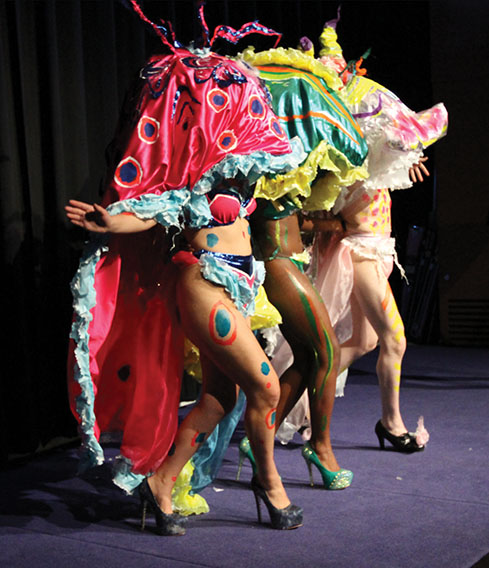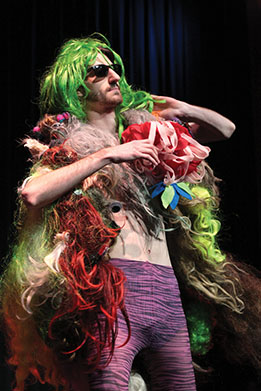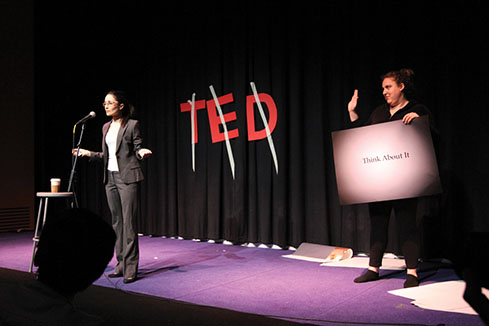 Summer 2013
Summer 2013|
“Some of them were hesitant at first, but I knew deep inside they had what it takes to perform. If they could get over their initial fears, they would blossom and explode into something fabulous.”
- Suzie Silver, Carnegie Mellon University Art Professor
|
Pop Caberate
Carnegie Mellon and The Warhol team up to inspire the next generation of performance artists.Stephanie Ross teeters across the stage of The Andy Warhol Museum in sky-high heels wearing nothing but tufts of lamb’s wool on top and sparkly briefs on the bottom. The 22-year-old Carnegie Mellon University student morphed herself into a “sexy sheep” for her Pop Cabaret class, a performance art collaboration between the university and the museum. In a spoof on the proverbial boxing-match ring girl she’ll strut in this wooly va-va-voom costume to announce act changes in an upcoming show. As she models for her classmates on the stage of the museum’s first-floor theater, a student calls out, “Your costume is awesome.” Ross, a senior art major, asks other students for their own iterations on sexy- strange creatures.
“Can I be a sexy alien?” asks Reese Adams, a sophomore. “You want to be a sexy alien?” “Yes, if possible.” Just about anything is possible in this semester-long class, which takes students off campus every Friday and molds them into a performance art troupe within the uninhibited, boundary-busting walls of The Warhol. The experience culminates in two live public performances. Suzie Silver, a CMU art professor, nudges her students to shed their inhibitions and create something thought-provoking, funny, outrageous, startling, sincere, or whatever—just so it makes a connection with the audience. “Some of them were hesitant at first,” she explains. “But I knew deep inside they had what it takes to perform. If they could get over their initial fears, they would blos- som and explode into something fabulous.” The idea for Pop Cabaret came about in February 2011 when Silver talked with Ben Harrison, curator of performing arts and public programs at The Warhol. Silver, who had done some performance art herself, was a regular at Off the Wall, The Warhol’s contemporary performance series devoted to chal- lenging conventional perceptions of art. Harrison asked if she had ever taught a performance art class. When Silver said there was no dedicated space for it on campus, Harrison suggested the museum’s theater. Silver jumped at the chance to have her students perform at such a prestigious venue. Harrison jumped at the chance to help grow a new generation of performance artists.
“I love the energy the students bring,” he says. “You walk in on a Friday afternoon and there are feather boas thrown everywhere and costume wigs and all kinds of crazy contraptions. It’s just a great theater workshop you wouldn’t normally see in a museum.” Harrison calls Pop Cabaret performances “subversive, playful, tongue-in-cheek, and experimental,” and very much in the spirit of Off the Wall. Born 13 years ago as a collaboration with Performance Space 122 in the East Village of New York, Off the Wall fits into the Warhol’s philosophy of being “more than a museum.” In 2003, The Warhol started producing the series on its own, attracting major talent such as Tammy Faye Starlite and David Cale, and even commissioned original work. Now, with its CMU collaboration, it’s helping to nurture new performance artists, who in turn bring their friends to events at the museum. Another major benefit: One of the Off the Wall performers visited the class, offering advice and inspiration. Shana Moulton, a CMU alumna who had Silver as an advisor, talked with students while she was in town to perform in February. The class also attends every Off the Wall performance. Silver says such experiences give her stu- dents license to explore. “Getting the students off campus gets them to think of themselves more as artists and less as students,” she says. “They just burst.” During a recent rehearsal, Silver asks Ross where she found the lamb’s wool for her costume. “I got it from a rancher in Arizona on Etsy,” says Ross, who is so enthralled with the class that she booked gigs of her own in Pittsburgh and New York. “That’s awesome,” Silver says. “It doesn’t even stink.” “Sheep are disgusting, but I love them,” counters Ross. Students take turns showing early versions of their performances to Silver, her “indispensable” teaching assistant, third-year MFA student Scott Andrew, and their classmates. The feedback they receive helps them refine their acts for public performances. Christin Bongioni, 19, a freshman art major, created an act that plays off her huge green eyes, which are so striking they draw frequent comments from strangers. In one of her other art classes, she had developed a big, teased wig that had an eye in the middle of the bouffant. She ran with that idea to create a creepy stripper persona. During her in-class performance, she took off her cabaret-style black dress, revealing a shock of plastic mannequin eyes glued to her body. She opened her own eyes so wide they appeared to bug out of her head as she lip-synched along with the song, “Private Eyes.” Her performance brought a lot of laughs but also some suggestions. One student says it would be even weirder to put plastic eyeballs in places such as her underarms. Silver told her to run with the idea of something “creepy, absurd, and excessive.” The students work hard to polish their performances, which are held not just in a classroom but before the eager public in shows that are so packed they have to turn people away. As Silver puts it, “I think it’s the coolest thing in the world that our students get to perform on the same stage as some of the best performance artists working today.”
|
Lost Kingdoms Found · Past Meets Present · Family Matters · Celebrating a Great Ride · Special Section: A Tribute to Our Donors · Chairman's Note · NewsWorthy · Face Time: Nick Bubash · Field Trip: “Shocking Success” in Libya · Science & Nature: Building for Bees · The Big Picture
 |
Copyright © 2017 CARNEGIE Magazine. All rights reserved. |



